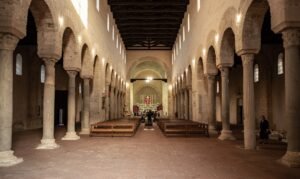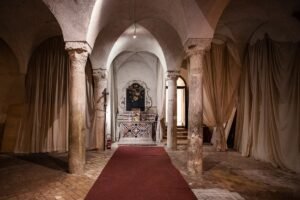Discovering Gerace (RC) means forgetting your surroundings to immerse yourself in the medieval atmosphere of one of Italy's most beautiful villages. It means venturing onto the rocky spur on which the village is perched to enjoy an incredible panorama and it means experiencing the solid local tradition of handicrafts, good food and millenary historical cultures. All this within a unique landscape, typical of the Aspromonte National Park, where this small village is located.
Gerace

The village of Gerace is located in the hinterland of the province of Reggio Calabria, is part of the Aspromonte National Park and lies on a rocky spur more than 450 metres above sea level. This is the typical perched village that, during the Middle Ages, offered shelter and safe protection from incursions by enemy populations, guaranteeing panoramic control over a rather extensive geographical area. Although there is evidence that dates back to Greek times, the actual settlement did not form until the 7th century A.D., when the Locresi (inhabitants of the city of Locri, located by the sea) moved here for reasons of geographic security. From a small defensive pole, thanks to its favourable elevated position not too far from the coast, Gerace became an important town at the centre of substantial trade: its population grew and numerous public and private buildings were erected over the centuries. Many are still visible today and it is possible to visit them and travel with the imagination, following in the footsteps of the Byzantines, passing through the Angevins, the Aragonese and the Bourbons. Currently, for the sake of convenience, it is possible to identify five city areas in which to move: the upper city (i.e. the old core); the Piana, or the 'lower' city; the Borghetto, the Borgo maggiore and the Castello, all of which are suggestive and worth a visit.
What we recommend you do, as soon as you arrive in Gerace, is turn off or disconnect all your devices and get in touch with the identity and nature of the place. Lose yourself in the narrow alleys, seek out ancient buildings and baroque churches and follow in the footsteps of the evocative historical testimonies of which the town is full! The upper part of the city, the oldest part, is perfect for all this: a visit to the Duomo (or Co-Cathedral of Santa Maria Assunta), which dates back to 1045 and will leave you speechless in its grandeur, is a must. Walk up to the Norman Castle and admire the view from above, breathing in the scent of history. Another beautiful view can be enjoyed from the Belvedere delle Bombarde, accessed by passing through Porta del Sole, one of the historical city gates that has survived over the centuries. Many churches from different eras await you with their small masterpieces to admire, such as the Church of St Francis, the Church of St John Chrysostom or the Church of St Catherine of Alexandria. Workshops (such as soap making or weaving) and guided tours in costume await visitors who want to treat themselves to an immersive experience in the history of the place, while a visit to the Castle, built in the 10th century and now almost reduced to ruins, is not to be missed. Finally, for lovers of trekking and unspoilt landscapes and nature, excursions to the Aspromonte National Park are always an excellent choice, at any time of year.
In Gerace, the authentic Aspromonte cuisine triumphs, linked to peasant traditions and the traditional processing of meat (especially Sunina meat). Hot chilli peppers, olive oil and handmade pasta served with goat sauce are never missing from the tables. Vegetables, such as dried tomatoes, olives, aubergines and stuffed peppers, accompany the ubiquitous capocollo or soppressata with their genuine flavour, to be tasted also (and especially!) in their spicy version. Very special dishes are curcudia, a particular polenta typical of the Aspromonte area, to be served with vegetables or with meat sauce, and pork rind with eggs, a hearty recipe with an intense flavour. There is also a great deal of space for wine: the most famous in the area is Greco di Gerace, a sweet, liqueur-like, amber-coloured raisin wine, but Mantonico Bianco, similar in taste and consistency, is also well known and appreciated. As for desserts, don't miss the cicerata, a fried dough made with boiled chickpeas, honey and cinnamon flavoured with citrus fruits, and the rafiole, or sweets made of biscuit sponge cake, garnished with a very white icing, an unmissable detail since it is the typical sweet of wedding feasts and for this reason always associated with the purity of the woman who is to take a husband.
There is no shortage of events and experiences in Gerace. The year opens with the New Year's Concert on 1 January and the Epiphany Concert on the 6th: both are held in the Cathedral, to the rhythm of religious Christmas music. The first Sunday after Easter is the Feast of Mary Most Holy of Prestarona: a religious feast, but at the same time a folk and country festival, which coincides with a fair of livestock and local handicrafts. In the summer, on the other hand, the Madonna del Carmine is celebrated, an occasion that includes a large party with fireworks and music, organised immediately after the religious ceremony and procession. But one of the most evocative events is undoubtedly "il borgo incantato" (the enchanted village), an international festival completely dedicated to art and street artists that takes place in July among the alleys of the village illuminated by the romantic light of torches and lanterns. Performances by jugglers and tightrope walkers are accompanied by tastings of typical products and musical performances, in a festive atmosphere that involves the entire village. Equally lively and heartfelt are the Feste Patronali, in which the town's patron saints Antonio del Castello, Veneranda and Immacolata are celebrated. The most eagerly awaited moment of the festivities is the Cavalluccio Ball, an ancient ritual that represents the struggle between good and evil. The cavalluccio is a puppet surmounted by the figure of a queen and is stuffed with gunpowder. The puppet is worn by a dancer who moves as the fireworks display begins around the audience, who are arranged in a circle, enjoying the show.














